Have you ever tried to play a video, but it won’t open? It’s frustrating, right?
Broken or unplayable video issues happen more often than you think. The file may be corrupted, or the download was incomplete, or may have any other cause. But don’t worry!
Fixing this problem is easier than it sounds. In this article, you will learn five simple ways to uncorrupt video files. These tips will help you save your videos and make them work again. Let’s dive in!
In this article
Part 1. Why Do Video Files Get Corrupted?

Many reasons can cause your videos not to play or get corrupted. Knowing them may help you resolve the problem and also tell you how you can avoid file corruption in the future.
Here are some of the very common reasons that might corrupt video files:
- Incomplete downloads or file transfers often result in unplayable video files.
- Sudden power outages during saving or editing can lead to file corruption.
- Malware or viruses can damage video files and make them unusable.
- Using old or outdated media players may cause playback issues.
- Faulty USB drives, SD cards, or hard drives can corrupt stored video files.
Part 2. Is It Possible to Fix Uncorrupt Video Files?
Yes, you can repair corrupted video files in most cases. Small issues like incomplete transfers or software problems can be fixed with simple tools. Even more serious problems, like damaged file headers, can sometimes be repaired using special software like Repairit.
However, success depends on the extent of the damage. If the file is not heavily corrupted, you can likely restore it. The good news is that plenty of methods are available to help you uncorrupt a video file. We will guide you through them in the next section.
Part 3. 5 Methods to Uncorrupt a Video File
Although there are various methods to help you fix the corrupted video files, some are difficult to follow, and some don't work. But don’t worry! We will guide you through some of the effective and easy methods to help you get your videos back to life. Let’s explore them!
Method 1. How to Uncorrupt a Video File Using Repairit
One of the most reliable and effective ways to uncorrupt a video file is Repairit Video Repair. This tool is your complete solution to resolve such issues. No matter if your file gets corrupted during a shoot, recording, editing, etc., Repairit will fix it. Also, it supports up to 20 video formats including, MOV, MTS, 3GP, MP4, and more.
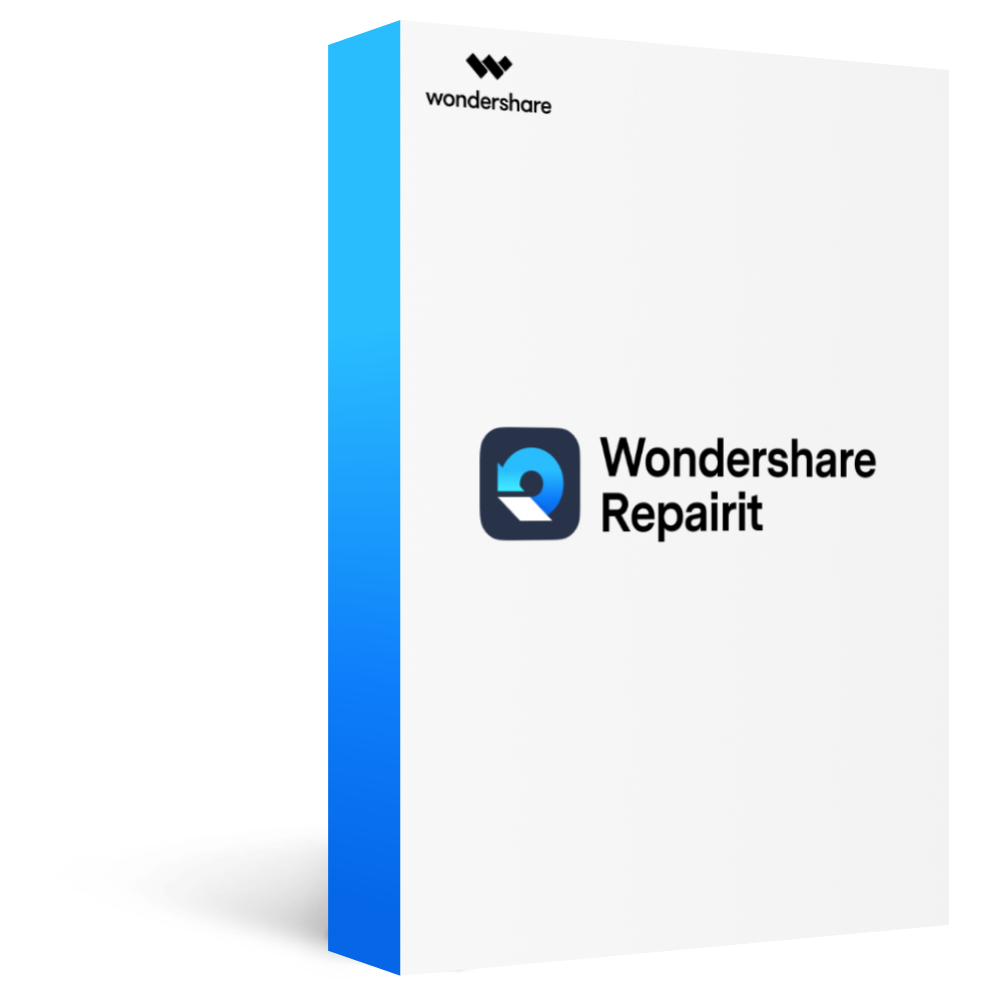
-
Repair damaged videos with all levels of corruption, such as video not playing, video no sound, out-of-sync video or audio, playback errors, header corruption, flickering video, missing video codec, etc.
-
Repair full HD, 4K, and 8K videos and support 18 popular formats, including MOV, MP4, M2TS, INSV, M4V, WMV, MPEG, ASF, etc.
-
Repair damaged or corrupted videos caused by video compression, system crash, video format change, etc.
-
Repair critically damaged or corrupted videos available on SD cards, mobile phones, cameras, USB flash drives, etc.
-
Repairit has a quick and advanced scanning mode. You can use either depending on the level of corruption the video file has undergone.
-
No limit to the number and size of the repairable videos.
-
Support Windows 11/10/8/7/Vista, Windows Server 2003/2008/2012/2016/2019/2022, and macOS 10.12~macOS 15.
Another aspect that makes this tool a top choice is its batch processing and preview features. You can save time by fixing multiple video files at a time. Moreover, You don't need to be a tech expert to use Repairit. With just a few clicks, you can watch your videos again.
Here are the steps for how to uncorrupt a video file using Repairit:
Step 1: First, download and install the Repairit software on your desktop. Once it's installed, launch it, and you will see the below interface. Click "+Add" and import your corrupt videos.
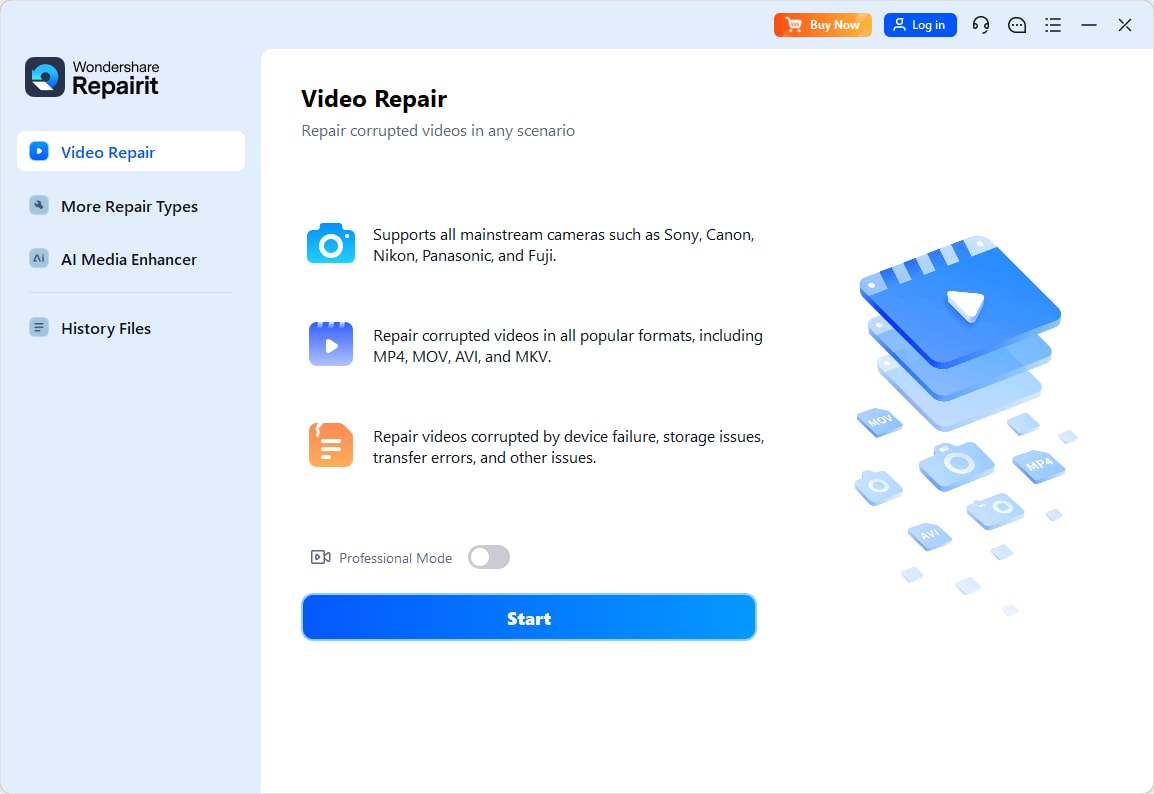
Step 2: After adding corrupted videos, you will see their list with information, including Image name, file size, file path, and more. Here, click the "Repair" button to start the repair process.
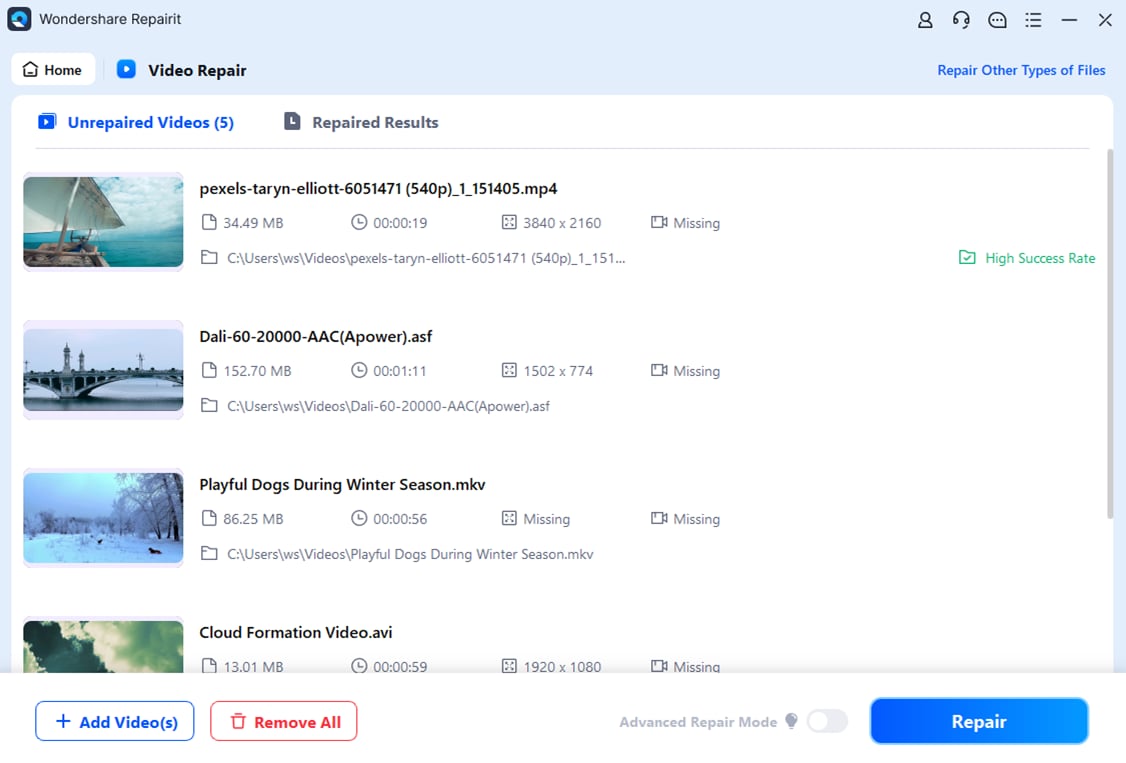
If you think that your videos are severely damaged, you can enable the ""Advanced ""Repair"" Mode."" However, you would need to upload a playable sample video in MP4 format from the same device. Then click "Repair" to start the process.
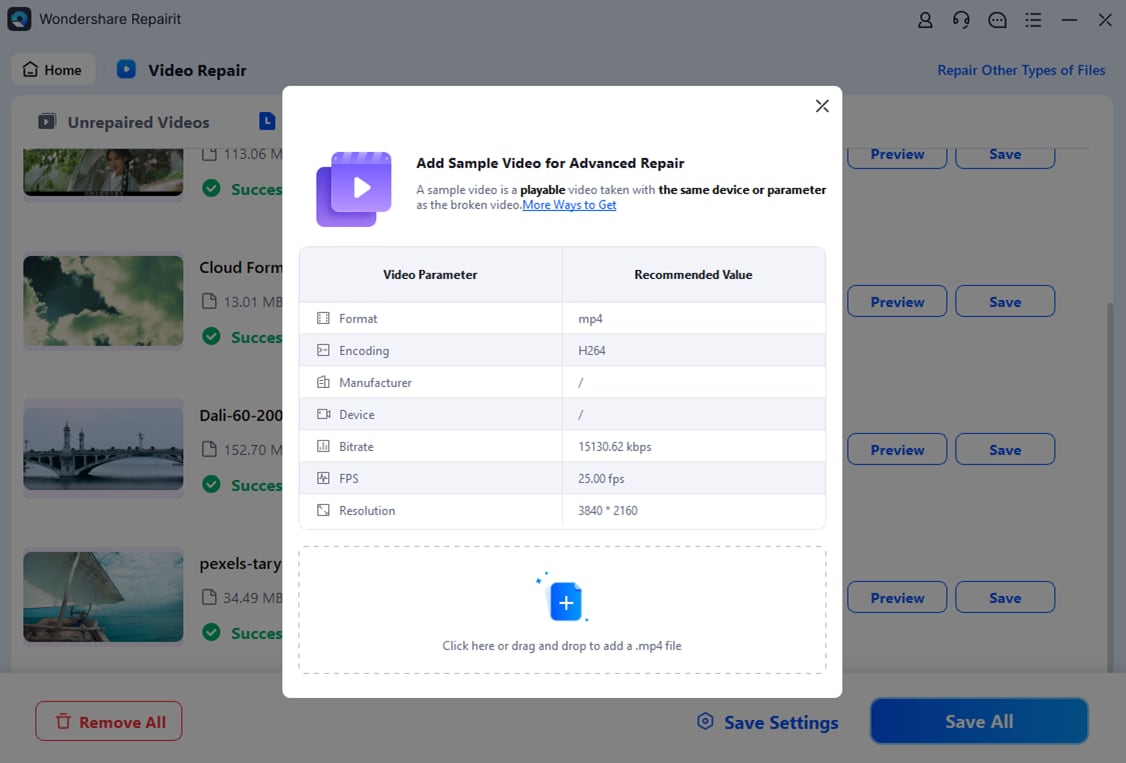
Step 3: Once the repair process is completed, you will see the interface below; click the "Preview" button to play the video. Or, click "Save" and then select a location to save the fixed video on your device.
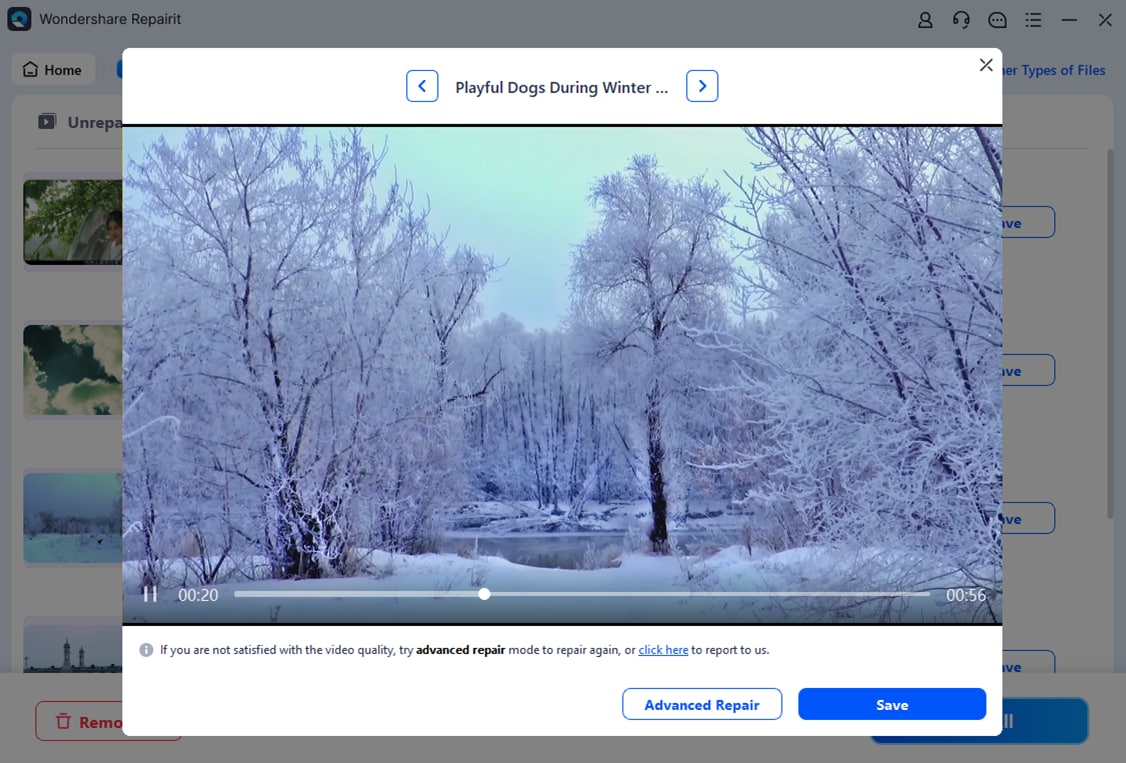
That's it! This is how you can uncorrupt video files with Repairit. No need for daunting steps or manual settings. Just a few clicks, and you are good to go.
Uncorrupt a Video File Using the Best Video Repair Tool

Method 2. Uncorrupt a Video File Via VLC
VLC is another way to uncorrupt video files. It is a popular media player, but it does more than just play videos. It comes with a built-in feature to play and fix your non-supported or corrupted AVI videos. This method may work for various file formats, including MP4, MOV, MKV, and more. You just have to enable the recovery codec feature in VLC.
After enabling it, whenever you play the video, VLC will detect if there is any problem related to the video file index. If it finds any, VLC will fix it automatically, and your video will be played without any error as if it never had a problem.
Step 1: Open the VLC media player, and go to "Tools" > "Preferences".

Step 2: Click the "Input/Codecs" button, scroll down, and click the drop-down menu next to "Damaged or incomplete AVI file". Select "Always Fix."

Step 3: After changing the required settings, click the "Save" button and play the video. Now, every time you play the video, VLC will check the damaged AVI files and fix them automatically.
Method 3. Uncorrupt a Video File By Converting Format
This is another method to uncorrupt video files. Technically, it just converts the video format and makes it playable on incompatible players. This method will work best if your video has compatibility issues. For example, Quicktime won't play MP4 videos if they have not been encoded with certain codecs. In that case, you can use VLC to convert the codecs.
Here is how to uncorrupt a video file by converting the format using VLC:
Step 1: Open the VLC player on your desktop. Click "Media" > "Convert/Save".

Step 2: Click "Add" and select the corrupt video you want to convert. Once selected, click the "Convert/Save " button.

Step 3: Next, choose the format that you want to convert your video to. You can do it by clicking the drop-down menu right next to "Profile."

Step 4: Once the format is selected, select the destination to which you want to save the converted video and click "Start. " VLC will start converting your video.

Once done, play the video and see if it has been fixed. Remember, this method will only tackle the issue related to the file index only.
Method 4. Restore a Playable Video File From Backup
This method is not a direct way to uncorrupt video files. However, it can save you from trouble. If you are one of those who regularly backup their data, it is a blessing in disguise. Remember, this only works if your video gets corrupted after you upload it to the backup. If your back is stored with the corrupted video, you won't be able to fix it.
You can follow the general steps given below to restore your corrupted video file from a backup.
Step 1: Open the platform or location where your backup is stored, e.g., cloud, external drive, etc.
Step 2: Search for the corrupted video file.
Step 3: Select the backup version of the file and copy it to your device. Play the video to ensure it works correctly.
Method 5. How to Uncorrupt a Video File Using Quicktime
QuickTime doesn’t repair corrupted video files like VLC or Repairit. However, it can help you understand the problem. By using the “Show Movie Inspector” feature, you can check details about the video. It will tell you things like the video’s format and other key information. While it won’t fix the file directly, this info can help you solve the issue.
Here is how you can uncorrupt a video file using Quicktime:
Step 1: Open Quicktime Player on your Mac and import the corrupted video file. You will see a blank screen if the video is severely damaged.
Step 2: Click "Windows" on the top menu bar and select "Show Movie Inspector".

Step 3: After clicking the Show Movie Inspector option, a message box will appear with all the details related to the video.

If you can find the error in the video details, you can seek further assistance from the internet and see how to fix it.
Part 4. Tips to Avoid Video File Corruption
Here are some tips that you can follow to avoid video file corruption:
- Regularly back up your videos by saving copies on external drives or cloud storage.
- Use trusted storage devices and avoid cheap or unreliable USB drives and SD cards.
- Always safely eject your external drives or USB devices to prevent file damage.
- Regularly update your media player and video editing software.
- Make sure to secure your files from malware using trusty antivirus software.
- Avoid turning off devices or closing programs while transferring videos or editing.
Final Words
Wrapping it up! Knowing how to uncorrupt a video file can help you recover lost content. There are many ways to fix corrupted videos, but Repairit works best. It quickly restores videos to their original quality, even when damaged.
Whether the corruption is from a bad transfer or storage issue, Repairit makes recovery simple. Don't let damaged videos stop you from enjoying or sharing them.
Related Video >>: What the User Says about Repairit?
Uncorrupt a Video File Using the Repairit Video Repair Tool

FAQ
Q. How do I know if my video file is corrupted?
You will know if a video is corrupted if it doesn’t play or shows errors. Common signs include no sound, freezing images, or a black screen. The video may only play part of the way or appear distorted. These are clear signs of file corruption.Q. Are there any risks involved when trying to uncorrupt a video file?
There are very few risks when using trusted tools to fix a video file. However, trying to repair a severely corrupted file could lead to further data loss. Always use reliable software and back up your files before attempting any repairs to avoid additional problems.Q. How can I prevent video corruption while recording?
To avoid corruption while recording, ensure your storage device has enough free space. Also, make sure to stop the recording process properly and avoid sudden power loss. Using a high-quality memory card or storage device can also reduce the risk of corruption during recording.


 ChatGPT
ChatGPT
 Perplexity
Perplexity
 Google AI Mode
Google AI Mode
 Grok
Grok
